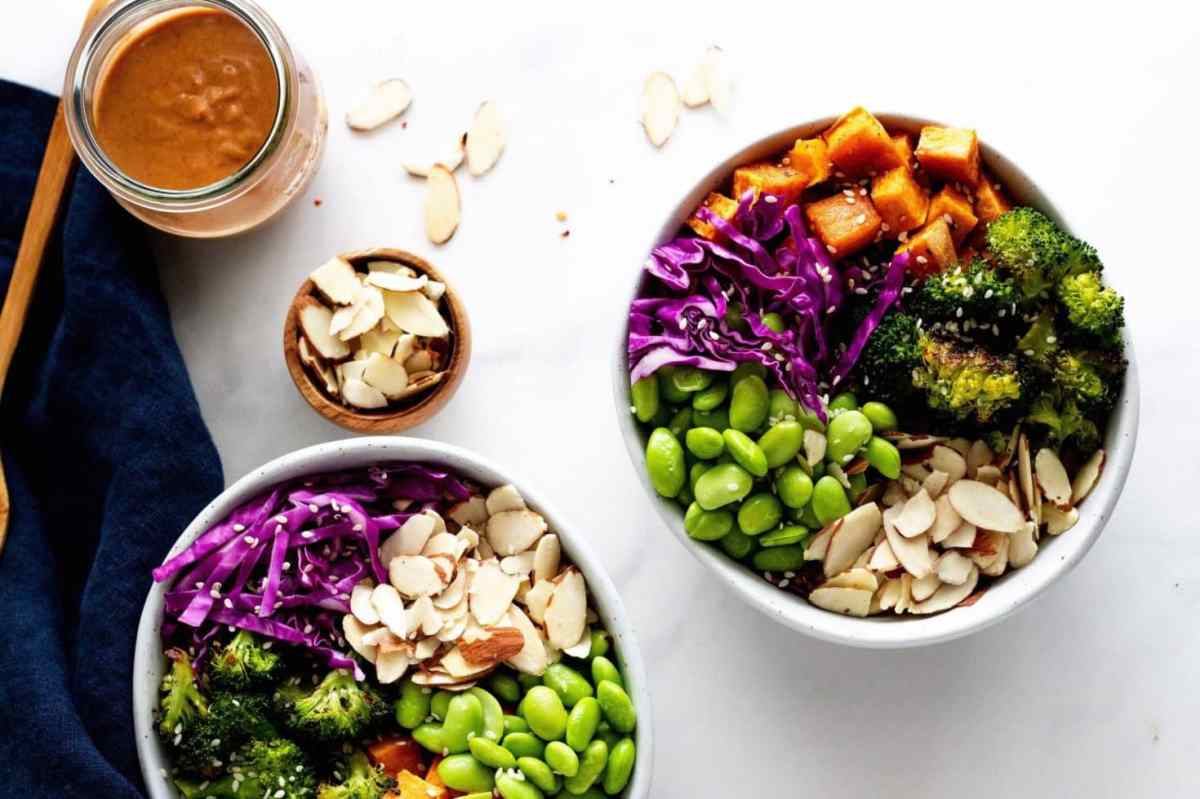Embark on a culinary journey exploring the vibrant world of vegetarian Buddha bowls! These aren’t your average salads; they’re a delightful explosion of textures, colors, and flavors, carefully crafted to nourish your body and soul. From the hearty protein base of lentils or tofu to the rainbow of seasonal vegetables and the perfectly balanced dressings, each bowl is a miniature masterpiece of healthy eating. Prepare to discover endless recipe variations, mastering the art of ingredient layering and flavor combinations to create your own signature Buddha bowl experience.
This comprehensive guide delves into the heart of Buddha bowl creation, providing detailed recipes, step-by-step instructions, and expert tips to elevate your culinary skills. Learn how to select the freshest, most seasonal ingredients, harness the power of diverse flavor profiles, and understand the nutritional benefits of each component. Whether you’re a seasoned cook or a kitchen novice, this guide empowers you to create visually stunning and incredibly flavorful vegetarian Buddha bowls that will leave you feeling satisfied and energized.
Flavor Combinations

Mastering the art of sauce and dressing is paramount to creating truly exceptional vegetarian Buddha bowls. The right sauce can elevate a simple bowl of grains, vegetables, and legumes into a symphony of flavors and textures. This section explores diverse flavor profiles and techniques for crafting dressings that perfectly complement the ingredients of your Buddha bowl.
Three Unique Dressing Recipes
Three distinct dressings, each offering a unique flavor profile, are presented below. These recipes are designed to showcase the versatility of Buddha bowl dressings and inspire culinary creativity.
| Ingredient | Quantity | Preparation | Notes |
|---|---|---|---|
| Peanut Butter (smooth) | 1/4 cup | Whisk until smooth | Use natural peanut butter for a richer flavor. |
| Soy Sauce | 2 tablespoons | Add to peanut butter | Adjust to taste. |
| Rice Vinegar | 1 tablespoon | Add to peanut butter and soy sauce | Adds a touch of acidity. |
| Maple Syrup | 1 tablespoon | Add to peanut butter, soy sauce and rice vinegar | Balances the saltiness. |
| Lime Juice | 1 tablespoon | Add to peanut butter, soy sauce, rice vinegar and maple syrup | Adds brightness. |
| Sesame Oil | 1 teaspoon | Add to peanut butter, soy sauce, rice vinegar, maple syrup and lime juice | Adds nutty aroma. |
| Water | 2-3 tablespoons | Add gradually until desired consistency is reached | Adjust for desired thickness. |
| Sriracha | 1/2 – 1 teaspoon | Add to taste | Optional, for a spicy kick. |
| Ginger (grated) | 1 teaspoon | Add to taste | Optional, for a warm flavor. |
| Ingredient | Quantity | Preparation | Notes |
|---|---|---|---|
| Orange Juice | 1/4 cup | Whisk together | Freshly squeezed is best. |
| Olive Oil | 2 tablespoons | Whisk together | Use a good quality extra virgin olive oil. |
| Rice Vinegar | 1 tablespoon | Whisk together | Balances the sweetness. |
| Maple Syrup | 1 tablespoon | Whisk together | Adjust to taste. |
| Dijon Mustard | 1 teaspoon | Whisk together | Adds a touch of sharpness. |
| Orange Zest | 1 teaspoon | Add at the end | Enhances the citrus flavor. |
| Ingredient | Quantity | Preparation | Notes |
|---|---|---|---|
| Sriracha | 2 tablespoons | Whisk together | Adjust to your spice preference. |
| Soy Sauce | 1 tablespoon | Whisk together | Adds saltiness and umami. |
| Rice Vinegar | 1 tablespoon | Whisk together | Provides acidity to balance the heat. |
| Honey or Maple Syrup | 1 teaspoon | Whisk together | Adds a touch of sweetness to cut through the spice. |
| Sesame Oil | 1/2 teaspoon | Add at the end | Adds nutty aroma and richness. |
Comparison of Popular Dressings
The flavor profiles of tahini, miso, and vinaigrette dressings offer diverse possibilities for Buddha bowls. Understanding their nuances allows for optimal pairing with various ingredients.
- Tahini Dressing: Creamy, nutty, and slightly bitter. Pairs well with roasted vegetables (like sweet potatoes or Brussels sprouts), chickpeas, and quinoa. The richness complements hearty ingredients.
- Miso Dressing: Umami-rich, savory, and slightly salty. Excellent with roasted vegetables, tofu, brown rice, and seaweed salad. The savory notes enhance earthy flavors.
- Vinaigrette Dressing: Light, acidic, and refreshing. Best suited for lighter ingredients such as leafy greens, cucumber, avocado, and grains. The acidity cuts through richer flavors.
Balancing Flavors in Buddha Bowl Dressings
Achieving a harmonious taste experience in a Buddha bowl dressing involves carefully balancing sweet, sour, salty, and savory elements. The goal is to create a complex and satisfying flavor profile that complements the other ingredients without overpowering them.
A well-balanced dressing typically includes a source of sweetness (e.g., maple syrup, honey), acidity (e.g., lime juice, rice vinegar), saltiness (e.g., soy sauce, tamari), and savory notes (e.g., miso paste, nutritional yeast). The proportions of each element should be adjusted to achieve the desired flavor balance.
For example, a peanut sauce might combine the sweetness of maple syrup, the saltiness of soy sauce, the acidity of lime juice, and the savory richness of peanut butter. A citrus vinaigrette might balance the sweetness of orange juice with the acidity of rice vinegar and the saltiness of a pinch of sea salt. Careful attention to these flavor components is key to creating a truly exceptional Buddha bowl experience.
Recipe and Step-by-Step Creation
Crafting a vibrant and flavorful vegetarian Buddha bowl is a delightful culinary journey. This recipe provides a comprehensive guide, allowing you to customize it to your preferences and dietary needs. The result is a visually stunning and nutritionally satisfying meal, perfect for a healthy lunch or dinner.
Ingredients and Preparation
This section details the ingredients needed and the step-by-step process of creating a delicious vegetarian Buddha bowl. Accurate measurements ensure a balanced and flavorful outcome.
- For the Quinoa Base: 1 cup quinoa, rinsed; 2 cups vegetable broth.
- For the Roasted Sweet Potatoes: 1 large sweet potato, peeled and cubed; 1 tablespoon olive oil; ½ teaspoon smoked paprika; ¼ teaspoon salt; ¼ teaspoon black pepper.
- For the Roasted Broccoli: 1 head broccoli, cut into florets; 1 tablespoon olive oil; ¼ teaspoon garlic powder; ¼ teaspoon salt; ¼ teaspoon black pepper.
- For the Chickpea Salad: 1 can (15 ounces) chickpeas, rinsed and drained; ¼ cup chopped red onion; 2 tablespoons chopped fresh parsley; 2 tablespoons lemon juice; 1 tablespoon olive oil; ¼ teaspoon cumin; salt and pepper to taste.
- For the Toppings: ½ cup pomegranate seeds; ¼ cup toasted slivered almonds; 2 tablespoons chopped fresh cilantro.
- Prepare the Quinoa: Combine quinoa and vegetable broth in a saucepan. Bring to a boil, then reduce heat, cover, and simmer for 15 minutes, or until all liquid is absorbed. (Image: A saucepan on a stovetop, with fluffy cooked quinoa visible.)
- Roast the Sweet Potatoes: Preheat oven to 400°F (200°C). Toss sweet potato cubes with olive oil, smoked paprika, salt, and pepper. Spread on a baking sheet and roast for 20-25 minutes, or until tender and slightly caramelized. (Image: A baking sheet with evenly roasted sweet potato cubes, glistening with oil and slightly browned edges.)
- Roast the Broccoli: Toss broccoli florets with olive oil, garlic powder, salt, and pepper. Spread on a baking sheet and roast alongside the sweet potatoes for the last 15-20 minutes, or until tender-crisp. (Image: A baking sheet with vibrant green broccoli florets, roasted to a slightly charred yet tender state.)
- Make the Chickpea Salad: In a medium bowl, mash chickpeas slightly with a fork. Add red onion, parsley, lemon juice, olive oil, cumin, salt, and pepper. Mix well to combine. (Image: A bowl containing a vibrant chickpea salad, with visible chunks of chickpeas, red onion, and parsley.)
- Assemble the Buddha Bowls: Divide cooked quinoa among bowls. Top with roasted sweet potatoes, roasted broccoli, and chickpea salad. Garnish with pomegranate seeds, toasted almonds, and fresh cilantro. (Image: Several visually appealing Buddha bowls, each layered with colorful ingredients, garnished with pomegranate seeds and almonds.)
Variations and Substitutions
Dietary needs and preferences can easily be accommodated by substituting ingredients. This ensures inclusivity and allows for personalized flavor profiles.
- Vegan: This recipe is already vegan. Ensure your vegetable broth is vegan-friendly.
- Gluten-Free: This recipe is naturally gluten-free. Confirm that all ingredients used are certified gluten-free if necessary.
- Different Grains: Substitute quinoa with brown rice, farro, or freekeh for variations in texture and flavor.
- Other Vegetables: Add roasted Brussels sprouts, bell peppers, or zucchini for added variety and nutrients.
- Protein Boost: Include toasted pumpkin seeds, sunflower seeds, or hemp seeds for extra protein and healthy fats.
- Different Beans: Black beans, kidney beans, or lentils can be substituted for chickpeas in the salad.
From the simple elegance of a perfectly layered bowl to the complex symphony of flavors dancing on your palate, the journey of creating vegetarian Buddha bowls is a rewarding one. This guide has equipped you with the knowledge and inspiration to craft countless variations, each a unique reflection of your culinary creativity and personal preferences. Embrace the versatility, experiment with different ingredients and flavor combinations, and savor the delightful experience of creating and enjoying these healthy and visually stunning meals. The possibilities are as boundless as your imagination!
Questions Often Asked
Can I make Buddha bowls ahead of time?
Yes! Prepare the components (grains, roasted vegetables, protein) separately and store them in airtight containers in the refrigerator. Assemble the bowls just before serving to maintain optimal freshness and texture.
What are some good substitutes for tofu?
Tempeh, chickpeas, black beans, edamame, or roasted sweet potatoes are excellent alternatives to tofu.
How do I store leftover Buddha bowls?
Store leftovers in an airtight container in the refrigerator for up to 3 days. Note that the texture of some components may change slightly after refrigeration.
Are Buddha bowls suitable for meal prepping?
Absolutely! Buddha bowls are perfect for meal prepping. Prepare the components in advance and assemble the bowls throughout the week.


